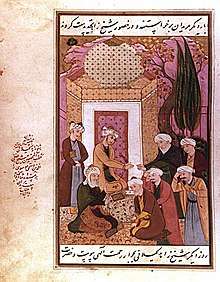Zahed Gilani
Taj Al-Din Ebrahim ibn Rushan Amir Al-Kurdi Al-Sanjani (or Sinjani; Persian: تاج الدين ابراهيم كردی سنجانی) (1216–1301), titled Sheikh Zahed (or Zahid) Gilani, was an Iranian Grandmaster (murshid-i kamil) of the famed Zahediyeh Sufi order at Lahijan. He is also known as Sultân-ûl Khalwatiyya [1] and Tadj’ad-Dīn Ebraheem Zāheed al-Geylānī as well.


| Part of a series on Islam Sufism |
|---|
|
List of sufis |
|
|
His life

Since the mid-13th century, Sheikh Zahed has been revered as a spiritual authority and his tomb near Lahijan in Iran's Gilan Province, on the shores of the Caspian Sea, draws numerous pilgrims to the village of Sheikhanvar. His ancestors came from the ancient Iranian city of Sanjan in Khorasan (located in present-day Turkmenistan). Fleeing the Seljuq invasion that would eventually conquer large parts of Persia, his ancestors settled in Gilan in the late 11th century. Taj Al-Din Zahed Gilani was able to attain cultural and religious influence on the Ilkhanid rulers (1256–1353), descendants of Genghis Khan, who followed Seljuq rule.
His most notable disciple was Safi-ad-din Ardabili (1252–1334), the Eponym of the Safavid Dynasty (1501–1736). He wed Zahed's daughter Bibi Fatima and, overgoing the interest of Zahed's firstborn son, Gamal Al-Din Ali, was entrusted with the Grand Master's Zahediyeh Sufi Order, which he transformed into his own, the Safaviyya (Sufi order) Order. Zahed Gilani's second-born son, Sadr al-Dīn, wed Safi Al-Din's daughter from a previous marriage. 170 years after Safi Al-Din's death (and 200 years after the death of Sheikh Zahed Gilani) Safaviyya had gained sufficient political and military power to claim the Throne of (Northern) Iran for the Safavid Heir, Shah Ismail I Safavi. The two families were to be intertwined for many centuries to come, by blood as well as mutual spiritual causes.
The Sil-silat-al-nasab-e Safaviyeh or Genealogy of the Safavids, was written by Pir Hossein Abdul Zahedi, a 17th-century descendant of Zahed Gilani. This hagiography in praise of the Safavid forebears, was devoted to the genealogy of the Safavid Sufi masters.
The Turkish Bayrami and Jelveti orders also had their origin in Zahed Gilani's Zahediyeh Sufi Order.
See also
References
- Abdülbaki Gölpınarlı, Türkiye'de Mezhepler ve Tarikâtlar (Madh'habs and Tariqat in Turkey), İnkılâp Yayınevi, 1997.
Further reading
- Bahadıroğlu, Mustafa (2000). "İBRÂHİM ZÂHİD-i GEYLÂNÎ". TDV İslâm Ansiklopedisi (in Turkish). 21. Istanbul: TDV İslâm Araştırmaları Merkezi. pp. 359–360. ISBN 975-3894-48-1.
- Esfandiar, Mahmoud-Reza (2016). زاهد گیلانی [Zahed Gilani]. In Haddad-Adel, Gholam-Ali (ed.). Encyclopaedia of the World of Islam (in Persian). 21. Tehran: Encyclopaedia Islamica Foundation. ISBN 978-600-447022-3.
- Yves Bomati and Houchang Nahavandi,Shah Abbas, Emperor of Persia,1587-1629, 2017, ed. Ketab Corporation, Los Angeles, ISBN 978-1595845672, English translation by Azizeh Azodi.
- E.G. Browne. Literary History of Persia. (Four volumes, 2,256 pages, and twenty-five years in the writing). 1998. ISBN 0-7007-0406-X
- Jan Rypka, History of Iranian Literature. Reidel Publishing Company. 1968 OCLC 460598. ISBN 90-277-0143-1
- Monika Gronke, Derwische im Vorhof der Macht. Sozial- und Wirtschaftsgeschichte Nordwestirans im 13. und 14. Jahrhundert. Wiesbaden 1993